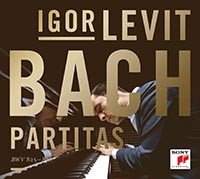Texte paru dans: / Appeared in:
|
|||||||||
|
Outil de traduction (Très approximatif) |
|||||||||
|
|
|||||||||
|
Reviewer: Huntley
Dent I am always drawn to the performer’s dilemma over how to play Bach on the piano when no route is without its bumpiness. Either the pianist wants to exploit the concert grand for what it is supremely good at—touch, color, and dynamics—or all of that is ignored in favor of imitating the harpsichord’s lightness, speed, and absolute evenness of tone. The esteemed Polish pianist Piotr Anderszewski’s Bach follows the first route, and he is almost as stubborn as Glenn Gould about going his own way, trusting his instincts over everything else. His style relies more on touch and expressive gestures than purists will probably tolerate. In the Sarabande of English Suite No. 3, for example, the opening statement is delivered forcefully at forte dynamic, which tapers off into piano and then pianissimo. It’s a mesmerizing effect. Throughout the program Anderszewski’s phrasing is free but nuanced—most of the time the tempo variations are limited to a sort of micro-rubato. Igor Levit’s gifts pull his playing in a different direction. He has remarkable evenness of touch and the ability to play the fastest passages smoothly, almost like a keyboard machine. The 27-year-old Russian-German (Anderszewski is 45) burst on the scene in 2013 with a set of late Beethoven sonatas that bowled many critics over by its tonal beauty; they were grateful for a pianist who pulled the thorns off the rose. Levit’s Bach is not only silky smooth and beautiful, but he stands aside as an interpreter. The Prelude to Partita No. 1 is like a cascade of pearls, each perfectly matched. There is none of Anderszewski’s mood-setting, and Levit’s rubato is even more micro when it appears at all. He usually sets a single dynamic and proves that it can be held indefinitely, with total finger control. The effect is in the ear of the listener—is it aloof, micromanaged, jewel-like, or Postmodern? You’ll have to judge for yourself. When listening to Anderszewski I’m more aware of melody and emotion; with Levit the marvel of Bach’s formal inventions comes into high relief, since he provides no distractions of pianistic color. Levit sees himself as responding emotionally, however. He says of the Minuet in Partita No. 5, “This is a humorous piece, not a minuet! And then suddenly it is one. And then it isn’t.” Of the stately Sarabande in the half-hour long Partita No. 6, he remarks, “At the end it’s not a sarabande anymore, but a crazy, radical free fantasy.” Yet Levit doesn’t permit himself much of the liberty we associate with fantasies. I think the program note is right that “a relaxed distance can be felt; a happy calm.” The pianist informs us that he intensively studied the partitas for three or four years and had to struggle with every note, as he did with late Beethoven. He’s come out the other side with remarkable poise and clarity. For me, Anderszewski is a more complete artist. In the complex fugue that serves as the Prelude to Suite No. 5, he attacks with force, giving each voice its own separate identify, creating shades of mood as Bach’s imagination shifts. Counterpoint is given personality. As it happens, Anderszewski made a 2002 recording of partitas Nos. 1, 3, and 6. It’s fascinating, comparing him with Levit, how Anderszewski plays the Gigue of Partita No. 1 as lightning-fast hopscotch between right and left hand. In Levit’s account the two hands aren’t playmates but chess masters, each one making formal moves countering the other. The Air in Partita No. 6 is extruded like a single thread by Levit, while each paragraph has a subtly different mood with Anderszewski. I’ve highlighted these differences, but in the end both pianists deliver Bach at the highest level of musicianship, and there’s no doubting their deep investigation into this endlessly compelling music. The recorded sound is up close and lifelike for both, and the pianos are fine. For non-specialists in Bach—and I count myself as one—the program notes to Anderszewski’s album are filled with extensive descriptions of the English Suites’s formal aspects and beauties. | |||||||||
|
|
|
||||||||
|
Cliquez l'un ou l'autre
bouton pour découvrir bien d'autres critiques de CD |
|||||||||





